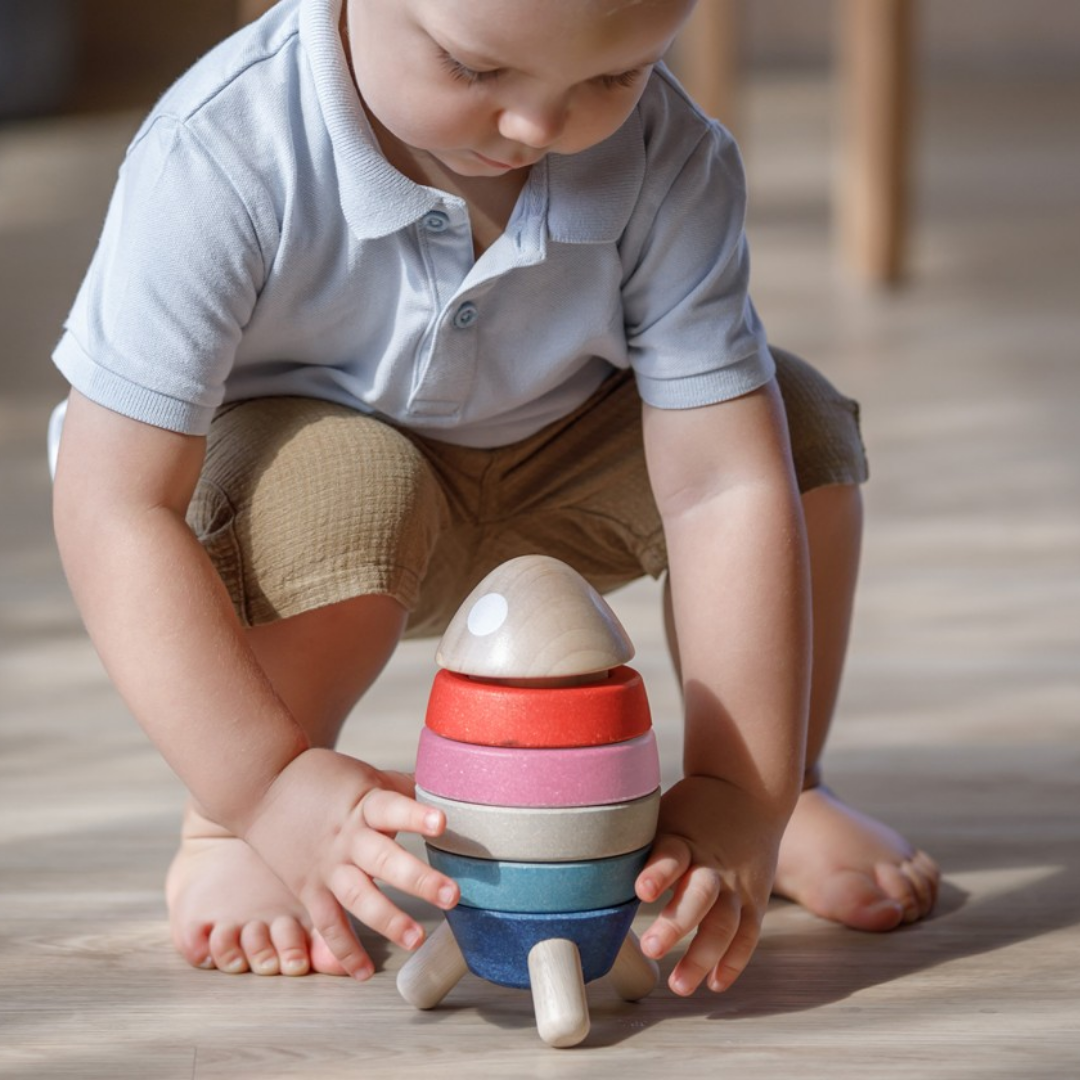
Not just "any" toy company… 10 things you didn't know about PlanToys
-
What was the inspiration behind starting PlanToys?
Back in 1981, seven university graduates came together with a shared desire to infuse the world with positivity! Vitool Viraponsavan, one of the strongest voices of the group, went on to establish PlanToys and has been inspiring children and families worldwide ever since. To this day, PlanToys operates with the belief that it’s their job to help educate and inspire society to prioritize environmental preservation, child safety and development. By raising children who are self-aware, environmentally-conscious and imaginative, it’s the company's hope that they will become individuals who understand the value of life, cherish nature, connection and play.
-
How does PlanToys accomplish its mission of creating “Better Kids, Better World”?
The PlanToys mission is defined by their Sustainable Way, which encompasses the three pillars of the business model – sustainable material, sustainable manufacturing, and sustainable mind. With these three pillars in place, PlanToys strives to nurture kids for a better world.
Sustainable Material: PlanToys ensures the use of sustainable, natural resources and create minimum to zero waste throughout our production process.
Sustainable Manufacturing: Children’s toys are manufactured with love using eco-friendly processes in every single step of production.
Sustainable Mind: PlanToys strive to give back to society and the environment through special environmental and educational campaigns that help make the world a better place for everyone.
-
What does the concept “learning through play” mean?
Play is a child’s work; they gain so much by exploring life through it! By playing creatively and freely, children develop physically, emotionally, socially, intellectually and imaginatively. There isn’t a single aspect of a child’s learning that isn’t impacted by free play. PlanToys are designed to help kids develop at every stage. So, “learning through play” implies that children can further develop and grow with PlanToys playthings in front of them.
-
What is “Sustainable Play”?
PlanToys define Sustainable Play as “a way of improving life through play and fostering positivity in oneself, society and environment.”
Play that is beneficial to oneself is play that helps one develop emotionally, physically, socially and intellectually.
Play that is beneficial to society is play that encourages people to better themselves through volunteer work, nature and relationship.
Play that is beneficial to the environment is play that nurtures one’s relationship with nature — encouraging them to live in an eco-friendly and positive way.
-
Why should parents opt for PlanToys? What sets them apart from the many other toy brands on the market?
There are 3 main reasons why we believe PlanToys are great for children:
The brand is passionate about child safety. We pay close attention to safety standards associated with our production process. All of our materials are non-toxic and environmentally friendly, so parents can let their children play without a worry
The brand helps children develop through play. Every parent wants to see their child successfully grow and develop. We believe that creative and educational play can help them do so! By playing with our educational toys, children learn and evolve in nearly every way
PlanToys deeply care about the environment. We believe that a quality environment will give rise to quality of individuals. At PlanToys, only water-based colors that are chemical free are used, E-Zero glue that doesn’t contain formaldehyde, and resource utilization is maximised by using sawdust to create a unique sustainable material called PlanWood. These examples of PlanToys' Sustainable Way protect mother earth and bring children closer to nature.
-
How are PlanToys products designed?
First, PlanToys are designed by working with child specialists to determine age-appropriateness of each toy alongside its developmental-aid potential. Then they move forward with eco-design principles that help anticipate and minimize negative environmental impacts from manufacturing (this includes things like sustainable materials and green production practices). As a result, parents can be assured that PlanToys items are child-safe, and intentionally-made of the highest quality.
-
What toys and types of play would PlanToys recommend for the first 3 years of a child’s life?
Let’s take a look at the early developmental stages of a child’s life and talk about the types of play that can support them as they hit various milestones.
Disclaimer: Below, we are simply aiming to provide guidance for parents. We do not claim to have medical expertise and believe you should always consult with your child’s physician if you have questions or concerns regarding your child’s development.
Newborn – 6 months
Visual and auditory stimulation as well as motor skill development are crucial during this time! Encourage your baby to focus on objects with their eyes by stimulating them visually with the PlanToys Play Gym or Mobile. Toys that rattle, jingle and make gentle sounds can stimulate a baby’s auditory cortex; and toys that encourage motor skill development — encouraging babies to reach, grasp and kick — can help strengthen them physically. As a newborn progresses, start looking at colourful pictures and reading stories together; look into mirrors and start to explore sensory play!
6 – 12 months
At this stage, babies start to further develop fine and gross motor skills — sitting up and starting to walk on their own! Sensory toys like the PlanToys Sensory Tumbling encourage sensory development and also improve fine motor skills. Movable toys like the Baby Car encourage vocalization and concentration. And, as your baby starts to take their first steps, the Walk N Roll or Bird Walker can support their mobility! Finally, simple puzzles, floating bath toys and active free-play toys invite babies to begin their journey of learning through play.
12 – 18 months
During this stage, little ones are developing their muscles and listening skills quickly. They are now able to hold themselves up and balance on their own, so push-and-pull toys are great options! Encourage your baby to practice hammering or pounding with the Hammer Balls; and also stimulate their senses through musical toys with the Oval Xylophone or Clatter! During this time, children are also starting to further develop social, emotional and intellectual skills, so toys that introduce them to different shapes, colors, sizes and patterns are beneficial. Explore the Chicken Nesting or Stacking Wheels, our wooden block sets, My First Camera or My First Phone!
18 months – 2 years
Support children as they strengthen their fine motor skills and hand-eye coordination during this stage with toys that invite them to grab, stack, sort, push and pull. Additionally, toys that emotionally stimulate — like the Solid Drum or Concertina — help children express themselves creatively. This is also a crucial time to introduce educational toys like the Stacking Ring or Sort N Count Cups as these playthings intellectually stimulate little ones and help them develop basic math and language skills early on.
2 – 3 years
At this stage, challenging a child’s gross motor skills, social and emotional development, and creativity are extra important! Toys that stimulate a child intellectually like the Geometric Sorting Board, Shape Sorter, Alphabet A-Z and Gears & Puzzle invite them to learn through play. Furthermore, pretend play toys like the Kitchen Set or Stand Mixer Set can assist children in their creativity and imaginative thinking. All of these toys also invite children to play actively!
-
Does PlanToys sell Montessori toys?
PlanToys are not marked as “Montessori toys”, but are designed and manufactured with the Montessori method at top of mind. As a Montessori-inspired toy manufacturer, PlanToys believe that children should have the freedom to self-direct while playing — using their creativity, imagination and bodies to express themselves. This gives children the freedom to both learn and develop while making mistakes, problem solving and learning along the way.
-
What makes PlanToys’ items unique?
The brand believes that what sets us apart most from other brands is our attention to detail. They intentionally consider every single step in our design, production and shipment process. By doing so, families around the world can see and feel the quality of our toys while also feeling good about the passion behind our sustainable mission.
- Premium-grade materials and intentionally-selected resources result in quality toys that don’t harm the environment.
- Simple designs make the toys classic, durable and timeless.
- Non-toxic, water-based dyes are used, that maintain the texture of PlanToys wooden toys — keeping them as close to their original nature as possible.
- Premium-grade materials result in quality toys that don’t harm the environment.
-
Does PlanToys cut down trees in order to produce toys?
PlanToys have never cut down a single tree for production! Instead, they add value to rubber trees by using them to their fullest potential. Typically, when rubber trees no longer produce latex, they are cut down and burned. This is where PlanToys come in! They take these rubber trees and use the rubberwood for our wooden toys. In 1981, PlanToys became the first company to do so. Let’s take a look at the lifespan of a rubber tree for a little more clarity:
The lifespan of a rubber tree:
- 0-5 years: Seedlings grow into small rubber trees.
- 2 5-25 years: During this time, farmers harvest latex. A rubber tree is typically valued because of its latex, which is priced higher than rubberwood.
- 5 years and beyond: Three years prior to removing rubber trees, farmers will stop adding fertilizer to the soil in order to save cost. This procedure naturally cleans up chemicals in the rubberwood before it is used for our toy production.
Share

